
Trillium is a genus of about fifty flowering plant species in the family Melanthiaceae. Trillium species are native to temperate regions of North America and Asia, with the greatest diversity of species found in the southern Appalachian Mountains in the southeastern United States.
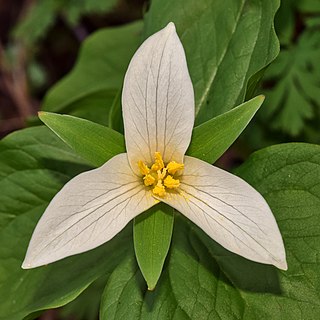
Trillium ovatum, the Pacific trillium, also known as the western wakerobin, western white trillium, or western trillium, is a species of flowering plant in the family Melanthiaceae. It is found in western North America, from southern British Columbia and the tip of southwestern Alberta to central California, east to Idaho and western Montana. There is an isolated population in northern Colorado and southern Wyoming.

Trillium luteum, the yellow trillium or yellow wakerobin, is a species of flowering plant in the bunchflower family Melanthiaceae with native populations in the Great Smoky Mountains of the United States and surrounding areas.

Trillium rugelii, also known as the southern nodding trillium or illscented wakerobin, is a species of flowering plant in the family Melanthiaceae. It is native to parts of the southeastern United States. It is found in the Great Smoky Mountains, Fernbank Forest, Steven's Creek Heritage Preserve, and other places of the Piedmont and southern Appalachian Mountains in Alabama, Georgia, South Carolina, North Carolina and Tennessee. It prefers to grow near streams in humus-rich soil under the shade of deciduous trees.

Trillium flexipes, known as the nodding wakerobin, bent trillium, or drooping trillium, is a species of flowering plant in the family Melanthiaceae. It is found from Minnesota to Ohio, south to Tennessee, with isolated populations in New York, Pennsylvania, Alabama, and other states. It is an endangered species in Ontario and possibly extirpated in North Carolina.
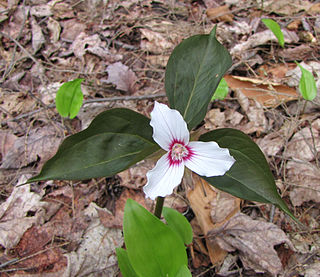
Trillium undulatum, commonly called painted trillium, painted lady, or trille ondulé in French, is a species of flowering plant in the bunchflower family Melanthiaceae. It is also known as smiling wake robin or striped wake-robin. The specific epithet undulatum means "wavy", which refers to the wavy edges of the flower petals. The plant is found from Ontario in the north to northern Georgia in the south and from Michigan in the west to Nova Scotia in the east.

Trillium cuneatum, the little sweet Betsy, also known as whip-poor-will flower, large toadshade, purple toadshade, and bloody butcher, is a species of flowering plant in the family Melanthiaceae. It is native to the southeastern United States but is especially common in a region that extends from southern Kentucky through central Tennessee to northern Alabama. In its native habitat, this perennial plant flowers from early March to late April. It is the largest of the eastern sessile trilliums.
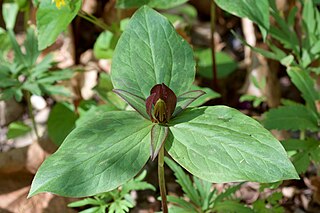
Trillium sessile, known as toadshade, sessile trillium, sessile-flowered wake-robin, and toad trillium, is a perennial spring wildflower native to the central part of the eastern United States and the Ozarks. Toadshade can be distinguished from other Trillium species by its single, foul smelling, stalkless, flower nestled in the middle of its three bracts. The bracts are sometimes, but not always mottled with shades of light and dark green. The specific epithet comes from the Latin word sessilis which means low sitting, referring to its stalkless flower.

Trillium cernuum is a species of flowering plant in the bunchflower family Melanthiaceae. The specific epithet cernuum means "drooping, curving forwards, facing downwards", a distinctive habit of its flower. It is commonly called nodding trillium or nodding wakerobin since the flower is invariably found nodding beneath the leaves. It is sometimes referred to as the northern nodding trillium to distinguish from Trillium rugelii, a similar nodding species native to the southern Appalachian Mountains. It is also called the whip-poor-will flower since presumably its bloom coincides with the spring arrival of the migrating bird with the same name.

Trillium vaseyi, the sweet wakerobin or sweet beth, is a spring flowering perennial plant which is found only in the southeastern United States, primarily in the southern part of the Appalachian Mountains but with a few populations farther south.
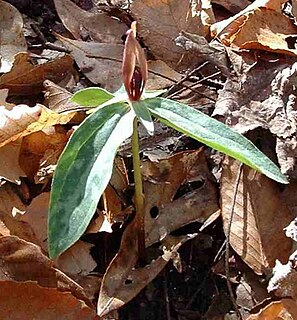
Trillium lancifolium, the lanceleaf wakerobin, lance-leaved trillium, or narrow-leaved trillium, is a species of plants native to the southeastern United States. It is known to occur in Alabama, Florida, Georgia, South Carolina, Tennessee and Mississippi. The species has protected status as an endangered species in both Florida and Tennessee.

Trillium sulcatum, the furrowed wakerobin, southern red trillium or Barksdale trillium, is a perennial wildflower that blooms in April and May. It is native to the southern Appalachian Mountains and nearby areas from West Virginia to Alabama.

Trillium pusillum is a species of flowering plant in the family Melanthiaceae known by the common names dwarf trillium, least trillium and dwarf wakerobin. It is native to the southeastern and south-central United States from Oklahoma to Maryland.

Trillium albidum, also known as giant white wakerobin, white toadshade, and sweet trillium, is a species of flowering plant in the family Melanthiaceae. The species is endemic to the western United States, ranging from west central California through Oregon to Washington. It is found in diverse habitats, on the moist slopes of mixed deciduous-coniferous forests, among shrubs and thickets, and along stream banks and river beds.
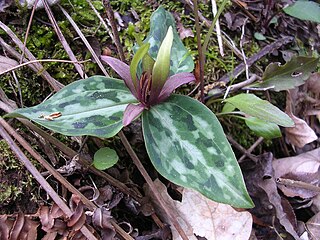
Trillium reliquum, the relict trillium, Confederate wakerobin, or Confederate trillium, is a monocotyledon species of the genus Trillium, a perennial, flowering, herbaceous plant of the family Liliaceae. It is found only in the southeastern region of the United States: southwest, central and east central Alabama, Georgia, South Carolina and Tennessee. As a relict species, there are a few remaining groups but it was once more abundant when conditions were different. Significant habitat loss has occurred through clearing of forests for agricultural and pine farm uses.

Trillium gracile, commonly known as the Sabine River wakerobin, slender trillium, or graceful trillium, is a species of flowering plant in the family Melanthiaceae. It is native to the region along the Sabine River in western Louisiana and eastern Texas. It generally grows in mature pine and hardwood forests, and on riverbanks.
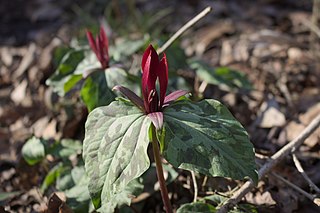
Trillium maculatum, the spotted wakerobin or spotted trillium, is a species of flowering plant in the family Melanthiaceae. It is found only in the eastern United States.
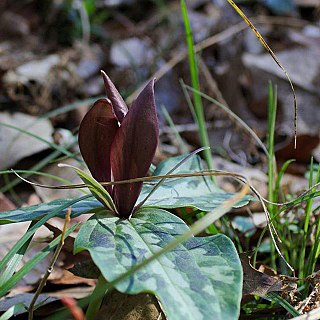
Trillium underwoodii, the longbract wakerobin, is a plant species found only in the southeastern United States.

Trillium ludovicianum, the Louisiana wakerobin or Louisiana trillium, is a species of flowering plant in the family Melanthiaceae. It is found only in the south-central United States, in Louisiana, Mississippi, and eastern Texas.
Trillium viride, commonly called the wood wakerobin, is a species of flowering plant in the family Melanthiaceae. It is found in the central United States, in certain parts of Missouri and Illinois. The specific epithet viride means "youthful" or "fresh-green", an apparent reference to the color of the plant's flower petals. For this reason, it is also called the green trillium, not to be confused with other green-flowered trilliums such as T. viridescens and the green form of T. sessile, both of which are found in Missouri.




















